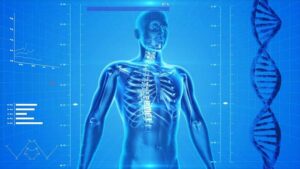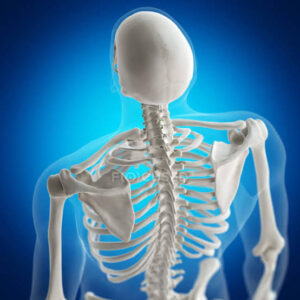The importance of bone health cannot be overstated.
During childhood, adolescence, and early adulthood, minerals are incorporated into your bones. You’ve reached your peak bone mass when you’re 30 years old.
Fragile bones are more likely to develop if not enough bone mass is built up during this period or if a bone loss occurs later in life.
It’s good to know that several nutrition and lifestyle habits can help to build and maintain strong bones.
Natural ways to build strong bones are listed below.
1. Be Consistent in Your Vegetable Intake
Your bones will thank you for eating a diet rich in vegetables.
Bone-forming cells are stimulated by vitamin C, which is found in citrus fruits. In addition, the antioxidant effects of vitamin C may protect bone cells from damage, according to some studies.
Bone mineral density, or bone density, may also be increased by eating vegetables.
Calcium and other minerals are found in your bones in the form of bone density. Both osteopenia and osteoporosis have a low bone density as a defining characteristic.
Increased bone mineralization in childhood and bone mass maintenance in young adults has been linked to a diet high in green and yellow vegetables.
It has also been found that eating a lot of vegetables can be beneficial to older women. Those who eat onions the most frequently have a 20% lower risk of osteoporosis than those who eat them less frequently.
Osteoporosis in older adults is linked to an increase in bone turnover or the breakdown and regrowth of bone.
More than nine servings a day of plants high in bone-protective antioxidants like broccoli, cabbage, parsley, or other greens decreased bone turnover in women over three months.
It has been found that a diet rich in fruits and vegetables during childhood helps to build strong bones and maintain bone mass in young adults and older women.
2. Strength training and weight-bearing exercises should be done regularly.
Bone health can be improved and maintained through the use of specific types of exercise.
Weight-bearing or high-impact exercise is one of the best activities for bone health because it encourages the formation of new bones. In children, including those with type 1 diabetes, this type of activity has been found to increase the amount of bone formed during the peak bone growth period.
The prevention of bone loss in the elderly can also be a huge benefit of this treatment.
Researchers have found that weight-bearing exercise in the elderly improves bone mineral density, strength, and size while also reducing markers of bone turnover and inflammation in these individuals.
Over nine months, one study found that the bone density of older men who performed the highest level of weight-bearing exercise showed little improvement.
You don’t have to be a bodybuilder to benefit from strength training. Osteoporosis, osteopenia, and breast cancer patients may also benefit from taking this supplement
Resistance training and weight-bearing exercise both increased bone density in various parts of the body, but only resistance training improved hip bone density, according to one study in men with low bone mass.
To sum it up, Training with weights and resistance exercises can help older adults, including those with low density, to maintain healthy bones as they age, according to a new study.
3. Consume the Right Amount of Protein
Bone health necessitates an adequate intake of protein. Bone is composed of about half protein.
Low protein intake has been linked to a decrease in calcium absorption and an increase in bone formation and breakdown
In addition, concerns have been raised that a high-protein diet may cause the body to expel calcium from the bones to counteract an increase in blood acidity. Research shows that this does not occur in people who consume up to 100 grams of protein daily, provided that they also consume plenty of plant foods and adequate calcium.
Studies show that higher protein diets benefit bone density in older women in particular.
Postmenopausal women who consumed more protein had a lower risk of fractures of the forearm, hip, spine, and total body, according to a six-year study of more than 144,000 women. A diet high in protein, on the other hand, may help maintain bone mass during weight loss.
At the end of one year, women who consumed more than 60 grams of protein per day lost more bone mass from their arm, spine, hip, and leg areas than those who consumed 86 grams of protein per day.
SHORT VERDICT:
Bone loss can be exacerbated by a diet low in protein, but a diet high in protein can help prevent bone loss as people age and lose weight.
4. Incorporate Calcium-Rich Foods Into Your Daily Diet
Calcium is the most essential mineral for strong bones, and your bones are primarily composed of this mineral.
To maintain bone density and strength, it is critical to consume adequate amounts of calcium daily.
The RDI for calcium is 1,000 milligrams per day for the majority of the population, but adolescents require 1,300 milligrams, while older women require 1,200 milligrams each day.
As a result, the amount of calcium you have in your body varies widely.
Intriguingly, your body absorbs far less calcium from a meal with more than 500 mg of calcium than it does from a meal with less.
As a result, it’s best to include one of these high-calcium foods at each meal to ensure that you get enough calcium throughout the day. Additionally, calcium supplements should be avoided in favor of foods rich in minerals.
A recent study of 1,567 people over 10 years found that, even though dietary calcium intake lowers the risk of heart disease, those who take calcium supplements have a 22% higher risk.
KEY POINT:
Calcium is the primary mineral in bones and must be consumed daily to maintain bone health. Calcium absorption is enhanced if you spread your intake out over the day.
5. Aim for a Balanced Diet Rich in Vitamins D and K
Bone health necessitates adequate intakes of vitamins D and K.
Vitamin D aids calcium absorption in the body, among other things. Osteopenia, osteoporosis, and other bone diseases can be prevented by maintaining a blood level of at least 30 ng/ml (75 nmol/l).
Vitamin D deficiency has been linked to a lower bone density in children and adults, as well as an increased risk of bone loss. Vitamin D deficiency is widespread, affecting an estimated one billion people around the world.
Getting enough vitamin D may be possible through sun exposure and food sources like fatty fish, liver,d cheese. Although many people need to take vitamin D supplements of up to 2,000 IU per day, this is not the case for everyone.
osteocalcin, a protein involved in bone formation, can be modified by vitamin K2 in improving bone health. Osteocalcin’s ability to bind to bone minerals has been improved as a result of this change.
MK-4 and MK-7 are the two most common forms of vitamin K2. The liver, eggs, and meat all contain trace amounts of MK-4. Nitto (soybean product) is one of the fermented foods that contacontain.
MK-7 supplements raised vitamin K2 blood levels more than MK-4, according to a small study in healthy young women.
The supplementation of either form of vitamin K2 supports osteocalcin modification and increases the density in children and postmenopausal women, however, other studies have shown.
Bone density was maintained in women between the ages of 50 and 65 who took MK-4 versus those who received a placebo for 12 months, according to a study.
In contrast, a 12-month study found no significant difference in bone loss between women who supplemented their diets with natto and those who did not supplement their diets with the legume
6. Avoid Diets with a Low-Calorie Content
It’s never a good idea to drastically reduce your caloric intake.
Rebound hunger and muscle mass loss are just some of the negative effects that can be caused by a low-calorie diet. Low-calorie diets have been linked to lower bone density in overweight and obese individuals, according to research.
The hip and upper thigh bone density of obese women who consumed 925 calories per day for four months decreased significantly regardless of whether they did resistance training or not, according to a study.
Eat at least 1,200 calories per day of a well-balanced diet for strong bones. Foods rich in vitamins and minerals that support bone health should be incorporated into the diet.
To sum it up, Supplementing resistance training with a low-calorie diet has been shown to reduce bone density. A daily calorie intake of 1,200 is recommended for bone health maintenance.
7. Take a Collagen Supplement, If Available.
Early evidence suggests that collagen supplements may be beneficial for bone health, despite the lack of extensive research on the subject. Bones are primarily protected by collagen. Contains glycine and proline and lysine, which help to build bone, muscle, ligaments, and other tissues.
Gelatin is the common name for collagen hydrolysate, which is derived from animal bones. For many years, it has been used to relieve joint pain.
Collagen appears to have beneficial effects on bone health as well, even though most studies have focused on its effects on joint conditions like arthritis.
Researchers found that giving postmenopausal osteoporosis patients the hormone calcitonin in combination with collagen led to significant reductions in markers of collagen breakdown after a 24-week trial was completed.
8. To keep your weight in check, keep it steady and healthy.
Bone health can be enhanced by eating a balanced diet and exercising regularly.
Osteopenia and osteoporosis risk factors include, but are not limited to, being underweight. As estrogen’s bone-protective effects wear off in postmenopausal women, this is an especially serious problem.
In fact, in this age group, low body weight is the primary cause of decreased bone density and bone loss. Obesity, on the other hand, has been linked to a decreased bone mass and an increase in the risk of bone fractured
Obesity can cause some bone loss, but it is usually less pronounced in obese people than in people who are of normal weight. A large amount of weight loss in a short period appears to be particularly harmful to bone health, as does losing and gaining weight repeatedly.
Repetitive cycles of losing and gaining weight can lead to significant bone loss throughout a person’s life, according to one recent study. Bone health is best protected by maintaining a normal or slightly higher-than-normal weight.
9. Include Magnesium and Zinc Rich Foods in Your Diet
Besides calcium, several other minerals play a role in bone health. Magnesium and zinc are two more that play a role.
The active form of vitamin D, which aids in calcium absorption, is created in part by the action of magnesium on vitamin D.
Magnesium supplementation has been linked to a 2–3 percent increase in bone density in women, according to a large study involving over 73,000 women.
Even though magnesium is present in many foods, the best sources are a few. Magnesium glycinate, citrate, or carbonate may be beneficial as a dietary supplement.
Tiny amounts of zinc are required by the body. As a building block for bone mineral content, calcium is an important mineral.
The formation of bone-building cells and the prevention of excessive bone breakdown are also facilitated by zinc.
Research shows that zinc supplements can help children grow stronger bones and older adults maintain bone density.
Beef, shrimp, spinach, flaxseeds, oysters, and pumpkin seeds are all good sources of zinc.
10. Omega-3-Rich Foods Should Be Consumed
The anti-inflammatory properties of omega-3 fatty acids are well-known. In addition, they have been shown to protect against bone loss as we age.
The omega-6 to omega-3 fat ratio must be kept in check as well as the omega-3 to omega-6 fat ratio.
Those with a lower ratio of omega-3 to omega-6 fatty acids had lower bone density than those with a higher ratio, according to a study involving over 1,500 adults aged 45 to 90. Generally speaking, it’s best to aim for a ratio of 4:1 or less between omega-6 and omega-3.
One controlled study found that omega-3 plant sources helped decrease bone breakdown and increase bone formation, even though most studies have focused on the long-chain benefits of omega-3 fats found in fish.
In addition to walnuts, chia seed is another source of omega-3 fats in the form of flaxseeds.
The Verdict
Bone health is critical at any age.
However, people tend to take their strong bones for granted because symptoms don’t appear until the bone loss has progressed to a more advanced stage.
Bone health can be achieved at any age through a variety of dietary and lifestyle choices, and it is never too early to begin.






